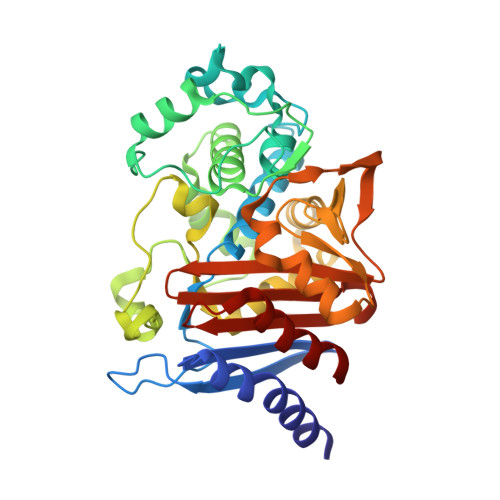Avibactam and Class C beta-Lactamases: Mechanism of Inhibition, Conservation of the Binding Pocket, and Implications for Resistance.
Lahiri, S.D., Johnstone, M.R., Ross, P.L., McLaughlin, R.E., Olivier, N.B., Alm, R.A.(2014) Antimicrob Agents Chemother 58: 5704-5713
- PubMed: 25022578
- DOI: https://doi.org/10.1128/AAC.03057-14
- Primary Citation of Related Structures:
4OOY - PubMed Abstract:
Avibactam is a novel non-β-lactam β-lactamase inhibitor that inhibits a wide range of β-lactamases. These include class A, class C, and some class D enzymes, which erode the activity of β-lactam drugs in multidrug-resistant pathogens like Pseudomonas aeruginosa and Enterobacteriaceae spp. Avibactam is currently in clinical development in combination with the β-lactam antibiotics ceftazidime, ceftaroline fosamil, and aztreonam. Avibactam has the potential to be the first β-lactamase inhibitor that might provide activity against class C-mediated resistance, which represents a growing concern in both hospital- and community-acquired infections. Avibactam has an unusual mechanism of action: it is a covalent inhibitor that acts via ring opening, but in contrast to other currently used β-lactamase inhibitors, this reaction is reversible. Here, we present a high-resolution structure of avibactam bound to a class C β-lactamase, AmpC, from P. aeruginosa that provided insight into the mechanism of both acylation and recyclization in this enzyme class and highlighted the differences observed between class A and class C inhibition. Furthermore, variants resistant to avibactam that identified the residues important for inhibition were isolated. Finally, the structural information was used to predict effective inhibition by sequence analysis and functional studies of class C β-lactamases from a large and diverse set of contemporary clinical isolates (P. aeruginosa and several Enterobacteriaceae spp.) obtained from recent infections to understand any preexisting variability in the binding pocket that might affect inhibition by avibactam.
- Infection Innovative Medicines, AstraZeneca R&D Boston, Boston, Massachusetts, USA sushmita.lahiri@astrazeneca.com richard.alm@astrazeneca.com.
Organizational Affiliation:

















